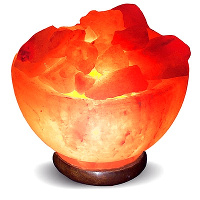Salt lamps are indeed beautiful. But do they emit meaningful levels of negative ions? Having personally tested a popular
brand of rock salt crystal lamp in our lab, we can attest that it was all but worthless as a generator
of high-density negative ions. After measuring the negative ion output level from the salt lamp, we took
our sensitive negative ion detector outdoors and measured a far higher lever of naturally occurring
negative ions than the salt lamp emitted. If the salt lamp's negative ion output would have been any lower, we
could not have measured it. The salt lamp put out such a small level of negative ions that just taking a reading
depleted the few
negative ions that it did put out, and then the ion detector stopped indicating. We then had to
remove the ion detector from near the salt lamp for a few minutes before we could again measure negative
ions near the lamp. We couldn't tell the exact level of ions. With high-density corona-discharge ionizers, the ion detector gives an
enormously stronger reading, that
does not decrease as it did when trying to measure the ion output from the salt crystal lamp. Moreover, the
intense level of negative ions from the corona-discharge ionizer are detectable at a considerably greater
distance (about 10 feet or more) than with the salt lamp (a few inches). Negative ions measured outdoors with a thunderstorm in the distance are much greater than we
measured from the salt lamp we tested. But still not as near as high as the intense levels of
negative ions from a corona-discharge
negative ionizer. |
"Some salt lamp manufacturers claim that the natural
absorption of moisture and its subsequent release through the heating effect of the lamp,
releases negative ions. Is this a fact?" We don't believe that it necessarily does by the way described above. Heat helps, but not that much, according to our findings. We measured the ion output only a few minutes after the salt lamp was plugged in, while the salt was still cold. Our research indicates that the photoelectric effect, rather than thermal emission, is the main mechanism that is responsible for the salt generating negative ions.
The bottom line: |
